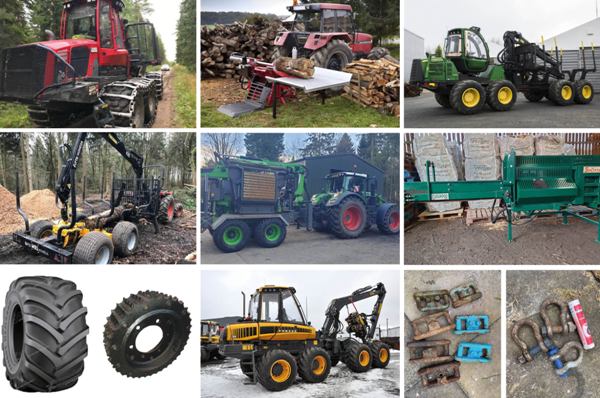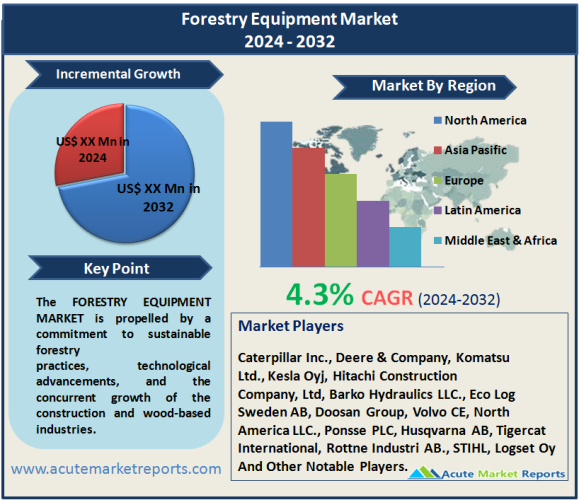
The forestry equipment market is expected to grow at a CAGR of 4.3% during the forecast period of 2025 to 2033. The market is propelled by a commitment to sustainable forestry practices, technological advancements, and the concurrent growth of the construction and wood-based industries. Nevertheless, environmental regulations and community concerns pose significant challenges. The segmentation highlights the dominance of specific product categories and felling techniques, while geographic trends underscore regional variations in market dynamics. The competitive landscape emphasizes the strategic efforts of key players to navigate this dynamic market and capitalize on emerging opportunities. As the industry evolves, adherence to environmental regulations and community engagement will be crucial for sustained success in the forestry equipment market.
Growing Demand for Sustainable Forestry Practices
The global emphasis on sustainable forestry practices emerges as a pivotal driver for the forestry equipment market. Governments, environmental organizations, and forestry companies are increasingly adopting sustainable harvesting methods to ensure the long-term health of forest ecosystems. This imperative is driving a surge in demand for modern felling equipment, including chainsaws, harvesters, and feller bunchers, designed to minimize environmental impact and promote responsible forestry.
Technological Advancements in forestry equipment
The continual evolution of technology in forestry equipment contributes significantly to market growth. Innovations such as GPS-guided harvesters and real-time data monitoring systems enhance precision and efficiency in forestry operations. By integrating cutting-edge technologies into extracting and on-site processing equipment, the industry ensures a more sustainable and productive approach to forest management. This technological evolution is evident in the widespread adoption of advanced forestry machinery across industry players.
Rising Global Construction and Wood-Based Industries
The growth of the global construction and wood-based industries acts as a driving force behind the demand for forestry equipment. The construction sector, reliant on timber for various applications, creates a steady demand for felling and extracting equipment. Additionally, wood-based industries require efficient on-site processing equipment to meet the demands of a growing market. This driver is substantiated by growth data in the construction and industrial sectors, indicating sustained demand for forestry products.

Market Restraint
Despite the positive trends, the forestry equipment market encounters a significant restraint related to environmental regulations and community concerns. Stringent regulations governing logging practices, combined with increasing awareness and activism around deforestation and habitat destruction, pose substantial challenges for the industry. Instances of legal battles and community protests against logging activities underscore the need for industry players to navigate regulatory landscapes judiciously and engage in sustainable practices.
Market Segmentation by Product
The market is intricately segmented into felling equipment, extracting equipment, on-site processing equipment, and other forestry equipment. In 2024, extracting equipment garnered the highest revenue, driven by its pivotal role in transporting harvested timber. However, the on-site processing equipment segment is anticipated to witness the highest Compound Annual Growth Rate (CAGR) during the forecast period from 2025 to 2033. This trend underscores the industry's increasing demand for efficiency in processing timber at the source.
Market Segmentation by Felling Equipment
Within felling equipment, the segmentation encompasses chainsaws, harvesters, and feller bunchers. Harvesters led in revenue in 2024, reflecting their efficiency and precision in large-scale forestry operations. However, the feller bunchers segment is poised to experience the highest CAGR during the forecast period, signaling a transformative shift toward more mechanized and specialized felling techniques.
Geographic Segmentation
The forestry equipment market exhibits diverse geographic trends, with varying revenue contributions and CAGR across regions. North America emerged as the region with the highest revenue in 2024, propelled by extensive forestry operations and a robust wood-based industry. Contrarily, the Asia-Pacific region is anticipated to experience the highest CAGR during the forecast period. This reflects the region's increasing construction activities and a growing focus on sustainable forestry practices, aligning with global environmental goals.
Competitive Trends
The forestry equipment market is characterized by competitive trends among key players, including Caterpillar Inc., Deere & Company, Komatsu Ltd., Kesla Oyj, Hitachi Construction Company, Ltd, Barko Hydraulics LLC., Eco Log Sweden AB, Doosan Group, Volvo CE, North America LLC., Ponsse PLC, Husqvarna AB, Tigercat International, Rottne Industri AB., STIHL and Logset Oy These industry leaders deploy strategies such as continuous product innovation, strategic partnerships, and acquisitions to fortify their market positions. In 2024, these players collectively contributed significantly to the market revenues, with expectations of a sustained upward trajectory during the forecast period from 2025 to 2033.
Historical & Forecast Period
This study report represents analysis of each segment from 2023 to 2033 considering 2024 as the base year. Compounded Annual Growth Rate (CAGR) for each of the respective segments estimated for the forecast period of 2025 to 2033.
The current report comprises of quantitative market estimations for each micro market for every geographical region and qualitative market analysis such as micro and macro environment analysis, market trends, competitive intelligence, segment analysis, porters five force model, top winning strategies, top investment markets, emerging trends and technological analysis, case studies, strategic conclusions and recommendations and other key market insights.
Research Methodology
The complete research study was conducted in three phases, namely: secondary research, primary research, and expert panel review. key data point that enables the estimation of Forestry Equipment market are as follows:
Market forecast was performed through proprietary software that analyzes various qualitative and quantitative factors. Growth rate and CAGR were estimated through intensive secondary and primary research. Data triangulation across various data points provides accuracy across various analyzed market segments in the report. Application of both top down and bottom-up approach for validation of market estimation assures logical, methodical and mathematical consistency of the quantitative data.
| ATTRIBUTE | DETAILS |
|---|---|
| Research Period | 2023-2033 |
| Base Year | 2024 |
| Forecast Period | 2025-2033 |
| Historical Year | 2023 |
| Unit | USD Million |
| Segmentation | |
Product
| |
|
Region Segment (2023-2033; US$ Million)
|
Key questions answered in this report